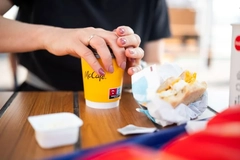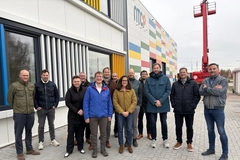Top Packaging Trends 2022: “Food Waste Fighters” combat climate, pandemic and political crises

23 Feb 2022 --- Innova Market Insights has unveiled its Top Packaging Trends 2022, with “Food Waste Fighters” taking the top spot. The climate crisis, COVID-19 pandemic and political upheavals have elevated food waste concerns, spotlighting the importance of shelf life-extending packaging for preserving perishable foods across complex, international supply chains.
Meanwhile, the market intelligence company has pinpointed “Monomaterial Mastery” as the second top trend, highlighting the transition away from hard-to-recycle, multilayer packaging to monomaterial solutions that are recyclable through existing infrastructure. Recycle-by-design packaging empowers brands to meet circular economy targets and secure favor with the growing eco-conscious consumer base.
“Bioplastic Boosters” is selected in third place in recognition of the globally expanding production and sophistication of biopolymers as biodegradable or compostable alternatives to fossil-based plastics, with the plastic pollution crisis raging on.
The top packaging trends are completed by “Labels Unleashed” and “Caps Uncovered,” documenting the increased focus on labels and caps as components of improved environmental sustainability and platforms for connective packaging technologies.
Food Waste Fighters
An environmental, economic and moral problem, if food waste were a country it would be the world’s third-biggest greenhouse gas emitter behind China and the US, according to the UN Food and Agriculture Organization. In today’s world of political strife, food waste concerns have been exacerbated by COVID-19 supply chain disruptions and international fallouts, such as Brexit and the Ukraine crisis.
These unprecedented challenges have given rise to shelf life-extending packaging solutions and a renewed appreciation for plastic, ranging from StePac’s top seals, pouches and MAP systems for fresh fruit and vegetables to Coveris’ sandwich skillets and Coexpan’s antimicrobial meat trays.
“The COVID-19 pandemic triggered a resurgence in plastics application, fueled by consumer concerns surrounding hygiene and safety,” notes Akhil Aiyar, projects leader at Innova Market Insights. “Suppliers have been quick to capitalize and abate plastic aversion by addressing the added value in terms of shelf life and product protection.” France has imposed a plastic ban on some fruit and vegetables, sparking food waste concerns.
France has imposed a plastic ban on some fruit and vegetables, sparking food waste concerns.
According to Innova Market Insights, over half of global consumers “agree” (37%) or “strongly agree” (25%) that the protective function of product packaging has become more important due to the COVID-19 pandemic. Moreover, 20% favor the increased use of plastics at this time, while 42% perceive them as an undesirable necessity.
Even in the contentious area of fruit and vegetable packaging, 16% of global consumers “strongly agree” and 30% “agree” that fresh produce should be packaged in a protective plastic layer due to the pandemic. France recently banned plastic packaging on some fruit and vegetables, while Spain is expected to implement similar regulations in 2023, against a backdrop of heightened food waste fears.
Meanwhile, the pandemic continues to accelerate the expansion of e-commerce, with consumers heavily reliant on grocery and takeaway home deliveries. With the virus’ severity in decline, 29% of global consumers remain “unsure” whether they will return to pre-pandemic shopping behavior, while 13% “do not expect” to return to physical retailers, according to Innova Market Insights.
E-commerce expansion brings its own food waste challenge, with sensitive products requiring protection and preservation over numerous touchpoints without increasing energy and waste levels. Greenpeace recently accused Amazon Fresh in Singapore of greenwashing after it adopted frozen water bottles for transit food chilling. However, carbon and waste-cutting solutions are available, such as Mondi’s corrugated BCoolBox, which replaces the need for high-energy cooling trucks with thermo-insulated packaging.
Monomaterial Mastery
Innova Market Insights has also monitored the trend toward monomaterial packaging across different materials and formats for increased recyclability, amid increasingly stringent circular economy targets. For example, the EU Plastics Strategy requires all packaging to be recyclable or reusable in an economically viable way by 2030, while “producer-pays” pressure mounts in the US.
While some packaging types enjoy relatively high recycling rates, like glass bottles, PET bottles, aluminum cans and steel cans, recycle-by-design solutions are more technically challenging in flexible packaging. “However, suppliers are focusing their efforts on the simplification of material components to move away from multilayer packages and developing alternatives to hard-to-recycle flexible packaging,” explains Aiyar. Extended Producer Responsibility schemes are driving monomaterial innovation.
Extended Producer Responsibility schemes are driving monomaterial innovation.
Flexible monomaterial solutions are increasingly prevalent, such as Bobst’s monomaterial plastic pouches, Camvac’s monofilm laminate chip packets, and Waddington Europe’s meat tray, which replaces the typical polyethylene layer or adhesive coating used to seal lids with a “tooth” profile.
“In fiber-based packaging, barrier coatings are being explored as alternatives to polymer liners to ensure that recyclability is not compromised when delivering comparable product protection to plastic packaging,” adds Aiyar.
DS Smith is investigating the use of water-soluble barriers and lamination technology to increase corrugated packaging’s recyclability. Likewise, Huhtamaki is developing monomaterial paper solutions for tea and coffee, and Coveris is rolling out high-barrier paper formats for dry foods. Meanwhile, SIG has launched the world’s first aluminum-free full barrier aseptic cartons for oxygen-sensitive products, and Dow has commercialized a recyclable, aluminum-free toothpaste tube.
Consumer appetite for recycling is on the rise. According to Innova Market Insights, 39% of global consumers say they recycle more than before the pandemic. Moreover, 52% perceive packaging that can be recycled as environmentally sustainable.
A key challenge is incorporating recycled content into packaging, which 41% of global consumers see as an important environmental sustainability issue, indicates the market researcher. Recycled material in plastic packaging remains low, although more stringent laws, like the upcoming UK Plastic Packaging Tax, are expected to boost a recyclate market suffering from low supply and cross-industry competition. Also, innovative recycling solutions, like Nextloopp’s marker technologies for separating food-grade polypropylene, are on the rise.
Bioplastic Boosters
Meanwhile, the expanding bioplastics market is generating a more serious challenge to fossil-based plastics, as patience with plastic pollution runs dry. Innova Market Insights notes increased scalability in biodegradable and compostable alternatives, such as Tipa’s food-grade, home-compostable laminate, and rigid bio-based formats, like Suntory’s plant-based PET bottle in Europe and Japan. Tipa’s food-grade, compostable laminate exemplifies bioplastics’ improved performance.
Tipa’s food-grade, compostable laminate exemplifies bioplastics’ improved performance.
“We have observed a steady switch toward the use of bio-based filler materials in e-commerce, along with developments in coating technologies and film solutions. Moreover, an increase in production capacity from existing facilities and greater capital investment bodes well for the future of bioplastics,” outlines Aiyar.
European Bioplastics has revealed global bioplastics production will more than triple over the next five years (2021-2026), with Asia predicted to surpass 70% market share by 2026. Packaging remains the largest field of application for bioplastics, with almost 48% (1.2 million tons) of the total bioplastics market in 2021.
Nonetheless, bioplastic market growth remains stunted by cost and policy challenges. While bioplastics are significantly more expensive than their petroleum-based competitors, legislation like the EU Single Use Plastics Directive (SUPD) fails to distinguish them from conventional plastics. However, Italy has exempted biodegradable and compostable plastics from its SUPD transposition, while the US COMPOST Act is set to boost composting infrastructure in the US.
Global consumers appear ready to embrace bioplastics, with 41% viewing biodegradability as the most environmentally sustainable end-of-life disposal method for packaging, followed by compostability (20%), according to Innova Market Insights.
Labels Unleashed
Labels are integral to consumer packaging, providing product information, tamper evidence and brand differentiation. At the same time, labels are notorious for hindering packaging recyclability, remaining attached during sorting and complicating material streams. However, Innova Market Insights has observed an industry shift toward easily-separable labels and recyclable or renewable label materials.
 If Greiner’s K3 r100 cup is not separated by consumers, pressure applied during the recycling process detaches the components.“Suppliers are focusing on improving label separation either through packaging design or alternate materials for label application,” highlights Aiyar. “Internet of Things technologies such as invisible watermarks and digital ecosystems are also being explored for large-scale rollouts, enabling easier sorting and recycling, and heightened consumer engagement through transparency and traceability.”
If Greiner’s K3 r100 cup is not separated by consumers, pressure applied during the recycling process detaches the components.“Suppliers are focusing on improving label separation either through packaging design or alternate materials for label application,” highlights Aiyar. “Internet of Things technologies such as invisible watermarks and digital ecosystems are also being explored for large-scale rollouts, enabling easier sorting and recycling, and heightened consumer engagement through transparency and traceability.”
Recycling-enhancing label innovation ranges from Avery Dennison’s wash-off adhesive label for PET containers to FrieslandCampina’s “zip-and-tear” bottle label and Greiner’s tear-off system for cups, which detaches under pressure.
The financial impetus for easily recyclable packaging is increasingly apparent, with half of global consumers “strongly agreeing” (17%) or “agreeing” (33%) they would pay more for more environmentally sustainable packaging, according to Innova Market Insights. Moreover, 23% “strongly agree” and 42% “agree” they would be willing to switch their usual brand for a brand with more environmentally sustainable packaging.
Packaging bans and circular economy targets are disrupting the conventional label market, driving alternative label concepts, like Laser Food’s Natural Branding, which lasers markings onto the surface of some fruits and vegetables. Lasered markings are also helping drive inclusivity in packaging, exemplified by P&G’s Herbal Essences’ hair care bottles for visually impaired consumers. Meanwhile, Coca-Cola has launched a label-free PET bottle in South Korea amid new national recyclability rules. Amcor’s Impression tech connects consumers and brands via digitally-enabled caps.
Amcor’s Impression tech connects consumers and brands via digitally-enabled caps.
Caps Uncovered
The statement “100% recyclable, excluding the cap” has been a feature of PET bottles for some time. However, as Innova Market Insights highlights, new EU legislation is concentrating efforts on caps as necessary and active components of the circular economy.
“Suppliers are making moves toward bio-based caps, while their recyclability is no longer considered an afterthought,” explains Aiyar. “Meanwhile, with incoming EU legislation stipulating that caps must remain attached to containers, the market is ripe for innovation in caps, closures and spouts.”
Leading beverage pack suppliers Tetra Pak, SIG, Elopak, Sidel and Alpla have come to market with tethered caps in anticipation of the 2024 regulation. Meanwhile, legislation like the UK Plastic Packaging Tax is driving up the use of recycled content, like Paccor’s recycled HDPE caps for dairy, Tetra Pak’s certified recycled polymers for cartons and Heinz’s recyclable ketchup bottle cap.
“Meanwhile, innovation in tamper-evident closures to alleviate heightened hygiene concerns and protect against counterfeiting have also seen an uptick in the past couple of years,” adds Aiyar.
Caps are also pivotal in the rise of connective packaging technologies, providing a platform for digitally-enhanced brand-consumer engagement, storytelling and environmental sustainability. Investment in this space includes Amcor’s digitally-customized closure liners and bottle caps, connecting packaging to smartphones.
By Joshua Poole











